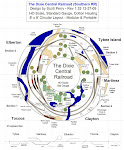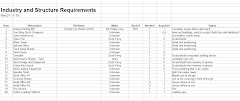
Click on the table to enlarge.
The table lists all the industries on the layout and what type of rolling stock it might receive or ship. Some industries require two cars sitting on the spur, one loading and one unloading. Boxcars are showing the highest density at 33% of the supply, so we'll have quite a few of these.
As a rule of thumb I like 40% of the rolling stock to be home road branded. This means I'll have an abundance of cars labeled for the Southern Railroad. Next, I'll have 25% branded as local railroads that interchange or are within close proximity of the railroad. So you will expect to see some L&N, TAG, ACL, Seaboard, CofG and other southern roads. A small 2% will be MOW cars. That leaves 33% to be non-southeastern roads. Here we'll add a Pensy, some Union Pacific and a few others. This will give us a nice and believable mix of traffic.
We're open for ideas and corrections, so if you see us headed down a dark path, enlighten us with a comment, below!








Great idea on the layout. I think you need to separate some of your cotton industries a bit, though. There are three main facilities that handle cotton products: Gins, compresses and oil mills.
ReplyDeleteThe gin simply separated the cotton seeds from the cotton fibers. Gins were commonly sheet metal structures and were located in almost every small town throughout the Cotton Belt. Gins took in loose cotton, graded it, separated the seeds, and shipped out the loose cotton and seeds separately. The seeds went to the oil mill while the loose cotton went to the compress.
At the compress, loose cotton was gathered up and put in a large steam-driven press and compressed (hence the name) into a cotton bale. These structures were often brick (or at least had brick firewalls) to prevent the whole mess from burning up in the event of a fire. The bales were then shipped out to textile mills for conversion to fabric, thread, etc. Many compresses often had gins on-site as well so they could take either pre-ginned or post-ginned cotton. A facility with both a gin and a compress usually advertised it as such in their name: "Aberdeen Gin and Compress".
At the oil mill, the cotton seeds were separated from the hulls. The seeds were processed into cottonseed oil. The remaining seed became cottonseed meal which could be used in animal feed. The hulls were also bagged and shipped to feed mills as roughage for cattle feed. The linters (the little sticky remaining pieces of cotton fiber) were also gathered up and sent to the feed mill.
A "Gin and Compress" is by far the best bang-for-your-modeling-buck industry. A G&C would receive coal for the steam boiler, loose cotton in boxcars, and baling supplies while shipping out cottonseed and baled cotton. Loose cotton might be in the form of pre-ginned cotton on the fields of your layout or post-ginned cotton from the railroad interchange. A G&C was truly a railroad-sized industry, especially in the 1920s!
Food for thought. Looking forward to whatever you build!
Rhett
Rhett, what great information! Thanks so much! A gin and compress it is. I've not read anything about a compress before, so I'll go look it up. Growing up in the deep south I've never even seen a compress. Maybe I'll make it Rhett's Gin and Compress! That has a real Southern ring to it!
ReplyDeleteThanks for the namesake!!
ReplyDeleteThere's a few older cotton compresses that are still standing in Mississippi. I tried to post links, but these comment boxes won't let me. Go to http://www.bing.com/maps and search for the following:
"Compress and Van Dorn, Holly Springs, MS"
"Compress and MS-35, Batesville, MS"
Those are two fairly small compresses which should be easy to model. The key features are the tower for the compress cylinder and the brick firewalls between the warehouse sections. For a truly huge compress, check out "Mclean St, Greenwood, MS."
I looked for similar facilities in Georgia on the Sanborn maps, but wasn't able to find any that are still standing. Here's the link to the free Georgia Sanborn maps (lucky you):
http://dlg.galileo.usg.edu/sanborn/
Cordele and Montezuma had neat compresses that were serviced by two railroads, one on each of two sides of the building. Unfortunately, neither appears to be standing today. This was quite common in towns with two or more railroads. The compress in Aberdeen, MS was served by the Mobile & Ohio, the Illinois Central, and the Frisco!!
Hello mate nice bblog
ReplyDelete